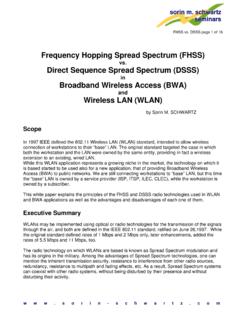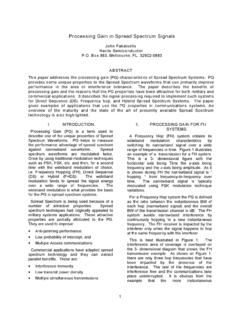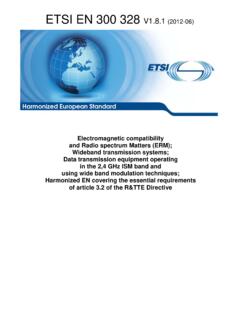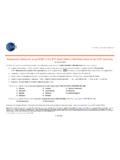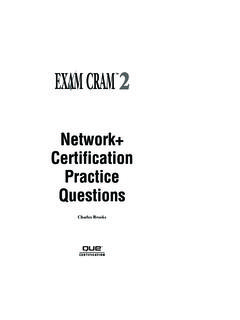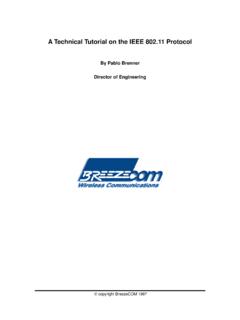Transcription of CC120X Low-Power High Performance Sub-1 GHz RF ...
1 CC120X SWRU346B Page 1 of 114 CC120X Low-Power high Performance Sub-1 GHz RF Transceivers User s Guide CC120X SWRU346B Page 2 of 114 Abbreviations Abbreviations used in this data sheet are described below. 2-FSK Binary Frequency Shift Keying LO Local Oscillator 4-FSK Quaternary Frequency Shift Keying LSB Least Significant Bit ACP Adjacent Channel power LQI Link Quality Indicator ADC Analog to Digital Converter MCU Microcontroller Unit AES Advanced Encryption Standard MSB Most Significant Bit AFC Automatic Frequency Compensation MSK Minimum Shift Keying AGC Automatic Gain Control NRNSC Non-recursive Non-systematic Convolutional ASK Amplitude Shift Keying OOK On-Off Keying BIST Built-In Self-Test PA power Amplifier BT Bandwidth-Time Product PD power Down CCA Clear Channel Assessment PER Packet Error Rate CRC Cyclic Redundancy Check PLL Phase Locked Loop CS Carrier Sense POR power -On Reset DC Direct Current PQT Preamble Quality Threshold CFM Custom Frequency Modulation PTAT Proportional to Absolute Temperature ESR Equivalent Series
2 Resistance QPSK Quadrature Phase Shift Keying FCC Federal Communications Commission RC Resistor-Capacitor FEC Forward Error Correction RF Radio Frequency FIFO First-In-First-Out RSSI Received Signal Strength Indicator FHSS Frequency Hopping Spread Spectrum RX Receive, Receive Mode FS Frequency Synthesizer RXDCM RX Duty Cycle Mode GFSK Gaussian shaped Frequency Shift Keying SPI Serial Peripheral Interface GPIO General Purpose Input/Output SRD Short Range Devices IF Intermediate Frequency TX Transmit, Transmit Mode I/Q In-Phase/Quadrature VCO Voltage Controlled Oscillator ISM Industrial, Scientific, Medical eWOR Enhanced Wake on Radio kbps kilo bit per second XOSC Crystal Oscillator ksps kilo symbol per second XTAL Crystal LNA Low Noise Amplifier CC120X SWRU346B Page 3 of 114 Table of Contents ABBREVIATIONS .. 2 TABLE OF CONTENTS.
3 3 1 OVERVIEW .. 5 2 CONFIGURATION SOFTWARE .. 6 3 MICROCONTROLLER INTERFACE .. 7 CONFIGURATION .. 7 SPI ACCESS TYPES .. 9 OPTIONAL PIN CTRL RADIO CONTROL FEATURE .. 17 GENERAL PURPOSE INPUT/OUTPUT CONTROL PINS .. 17 4 ON-CHIP TEMPERATURE SENSOR .. 22 5 COMMON RECEIVE AND TRANSMIT CONFIGURATIONS .. 23 DATA COMMUNICATION MODES .. 23 MODULATION FORMATS .. 24 FORWARD ERROR CORRECTION .. 29 SYMBOL RATE PROGRAMMING .. 29 6 RECEIVE CONFIGURATION .. 30 RX FILTER BANDWIDTH .. 30 DC OFFSET REMOVAL .. 31 FEEDBACK TO PLL .. 32 AUTOMATIC GAIN CONTROL .. 33 IMAGE COMPENSATION .. 34 BIT SYNCHRONIZATION .. 35 BYTE SYNCHRONIZATION, SYNC WORD DETECTION .. 35 PREAMBLE DETECTION .. 36 RSSI .. 37 COLLISION DETECTOR .. 42 CLEAR CHANNEL ASSESSMENT (CCA) .. 42 LISTEN BEFORE TALK (LBT) .. 43 LINK QUALITY INDICATOR (LQI).
4 43 7 TRANSMIT CONFIGURATION .. 44 PA OUTPUT power PROGRAMMING .. 44 OOK/ASK BIT SHAPING .. 45 8 PACKET HANDLING HARDWARE SUPPORT .. 46 STANDARD PACKET FORMAT .. 46 PACKET FILTERING IN RECEIVE MODE .. 52 PACKET HANDLING IN TRANSMIT MODE .. 53 PACKET HANDLING IN RECEIVE MODE .. 53 PACKET HANDLING IN FIRMWARE .. 53 TX FIFO AND RX FIFO .. 54 IEEE SUPPORT .. 55 FRAME CHECK SEQUENCE (FCS) .. 59 TRANSPARENT AND SYNCHRONOUS SERIAL OPERATION .. 59 9 RADIO CONTROL .. 62 power -ON START-UP SEQUENCE .. 62 CRYSTAL CONTROL .. 62 VOLTAGE REGULATOR CONTROL .. 62 ACTIVE MODES .. 63 RX TERMINATION .. 64 ENHANCED WAKE ON RADIO (EWOR) .. 67 RX SNIFF MODE .. 70 RX DUTY CYCLE MODE .. 72 RC OSCILLATOR CALIBRATION .. 73 ANTENNA DIVERSITY AND MULTIPLE PATH TRANSMISSION .. 73 RANDOM NUMBER GENERATOR .. 74 RF PROGRAMMING.
5 74 FREQUENCY SYNTHESIZER 75 CC120X SWRU346B Page 4 of 114 IF PROGRAMMING .. 75 FS CALIBRATION .. 76 FS OUT OF LOCK DETECTION .. 76 10 AES .. 77 AES BLOCK OPERATION .. 77 AES 77 AES PARAMETERS .. 77 AES TX/RXFIFO OPERATION .. 78 11 SYSTEM CONSIDERATIONS AND GUIDELINES .. 79 VOLTAGE REGULATORS .. 79 SRD REGULATIONS .. 79 FREQUENCY HOPPING AND MULTI-CHANNEL SYSTEMS .. 79 CONTINUOUS TRANSMISSIONS .. 79 BATTERY OPERATED SYSTEMS .. 79 12 REGISTER DESCRIPTION .. 80 13 SOLDERING INFORMATION .. 114 14 DEVELOPMENT KIT ORDERING INFORMATION .. 114 15 REFERENCES .. 114 16 GENERAL INFORMATION .. 114 DOCUMENT HISTORY .. 114 CC120X SWRU346B Page 5 of 114 1 Overview CC120X is a family of high Performance low power RF transceivers designed for operation with a companion MCU. The purpose of this user s guide is to describe configurations and functionality available for implementing a wireless system.
6 CC120X automates all common RF related tasks, greatly offloading the MCU. Below is a block diagram showing the different parts of the transceiver divided in an RF related part and a part for digital support functionality. BIASRBIASXOSC_Q1 XOSC_Q2 XOSCLNA090 FREQ SYNTHADCADCDEMODULATORPACKET HANDLERRXFIFOMODULATORTXFIFORADIO CONTROL & power MANAGEMENTLNA_PLNA_NPAEXT_XOSCPALFC1CS_N SISO (GPIO0)SCLKGPIO2 GPIO1 GPIO3 DIGITAL INTERFACE TO MCULFC0 CC120xMARCMain Radio Control unitUltra low power 16 bit MCU256 byteFIFO RAMbuffer4 kbyte ROM RF and DSP frontendPacket handlerand FIFO controlConfiguration andstatus registerseWORE nhanced ultra low powerWake On Radio timerSPI Serial configurationand data interfaceInterrupt andIO handlerSystem busPA outLNA_PLNA_N90 dB dynamic range ADC90 dB dynamic range ADCHigh linearityLNA14 dBm highefficiency PAChannel filterXOSCC ordicAGCA utomatic Gain Control, 60dB VGA rangeRSSI measurements and carrier sense detectionHighly flexible FSK / OOK demodulator(optional bit clock)
7 (optional low jitter serial data output for legacy protocols)Data interface with signal chain accessXOSC_Q1 XOSC_Q2 Ultra low power 40 kHz auto-calibrated RC oscillator(optional 40 kHz clock intput)CSn (chip select)SI (serial input)SO (serial output)SCLK (serial clock)(optional GPIO3/2/0 ModulatorFully integrated fractional-Nfrequency synthesizerOutput power ramping and OOK / ASK modulationIF ampIF amp(optional auto detectedexternal XOSC / TCXO)(optional GPIO for antenna diversity)IQBattery sensor / temp sensorPower on resetAES-128 accelerator Figure 1: CC120X Block Diagram CC120X can be configured to achieve optimum Performance for many different applications using the SPI interface (see Section for more details). The following key parameters can be programmed: power -down/ power -up mode (SLEEP/IDLE) Crystal oscillator power -up/ power -down (IDLE/XOFF) Receive/transmit mode (RX/TX) Carrier frequency Symbol rate Modulation format RX channel filter bandwidth RF output power Data buffering with separate 128-byte receive and transmit FIFOs Packet radio hardware support Data whitening Enhanced Wake-On-Radio (eWOR) Figure 1 shows a simplified state diagram.)
8 For detailed information on controlling the CC120X state machine see Section 9. CC120X SWRU346B Page 6 of 114 Transmit modeReceive modeIDLEM anual freq. synth. calibrationRX FIFO ERRORTX FIFO ERRORF requency synthesizer onSFSTXONSRX or wake-on-radio (WOR)STXSTXSTX or RXOFF_MODE=10 RXOFF_MODE = 00 SFTXSRX or TXOFF_MODE = 11 SIDLESCALSFRXIDLETXOFF_MODE = 00 SFSTXON or RXOFF_MODE = 01 SRX or STX or SFSTXON or wake-on-radio (WOR)SLEEPSPWD or wake-on-radio (WOR)Crystal oscillator offSXOFFCSn = 0 CSn = 0 TXOFF_MODE = 01 Frequency synthesizer startup, optional calibration, settlingOptional freq. synth. calibrationDefault state when the radio is not receiving or transmitting. Lowest power mode. Most register values are retained (see Table 5 for details ). All register values are retained. Used for calibrating frequency synthesizer upfront (entering receive or transmit mode can then be done quicker).
9 Transitional state. Frequency synthesizer is turned on, can optionally be calibrated, and then settles to the correct frequency. Transitional state. Frequency synthesizer is on, ready to start transmitting. Transmission starts very quickly after receiving the STX command transitional state. In FIFO-based modes, transmission is turned off and this state entered if the TX FIFO becomes empty in the middle of a packet. In FIFO-based modes, reception is turned off and this state entered if the RX FIFO overflows. SRX Figure 2: Simplified State Diagram 2 Configuration Software CC112X can be configured using the SmartRF Studio software [1]. SmartRF Studio is highly recommended for obtaining optimum register settings, and for evaluating Performance and functionality. After chip reset, all registers have default values and these might differ from the optimum register setting.
10 It is therefore necessary to configure/reconfigure the radio through the SPI interface after the chip has been reset. SmartRF Studio provides a code export function making it easy to implement this in firmware. CC120X SWRU346B Page 7 of 114 3 Microcontroller Interface Configuration In a typical system, CC120X will interface to an MCU. This MCU must be able to communicate with the CC120X over a 4-wire SPI interface to be able to: Configure the CC120X Program CC120X into different modes (RX, TX, SLEEP, IDLE, etc) Read and write buffered data (RX FIFO and TX FIFO) Read status information 4-wire Serial Configuration and Data Interface CC120X is configured via a simple 4-wire SPI-compatible interface (SI, SO, SCLK, and CSn) where CC120X is the slave. This interface is also used to read and write buffered data.










